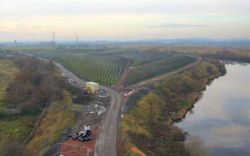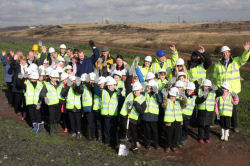Fryston and Wheldale Collieries Remediation |
|
Type of Award: Whole Project Award
Project Team:
Client: Wakefield
Metropolitan District Council / Yorkshire
Forward
ECC Project Manager/ Construction Design Management Co-ordinator
(CDMC): EC
Harris
Contractor: Birse
Civils Limited
Designer: Scott
Wilson
 |
|
The project
The reclamation of Fryston and Wheldale Collieries sites, as part of the Coalfields Regeneration scheme, was delivered by Yorkshire Forward, supported by landowners Wakefield MDC utilising funding provided by the Homes and Communities Agency through the National Coalfields Programme. The scheme was an Early Contractor Involvement (ECI) contract with the ECI phase valued at £1.5m and the main works valued at £8.5m. Both the ECI and main works were won by Birse Civils. Construction commenced on site in July 2008.
ECI works involved general site clearance, formation of a 2-km-long access track through the site, excavation and crushing of existing concrete stockpiles for use as 6F2 on site and establishment of a perimeter footpath for pedestrian use throughout the construction phase. The site had been used as a recreation facility by the local community and it was important to maintain this provision.
 |
|
The main works included:
- excavation and burial of approximately 1,500 cubic metres of Japanese Knotweed within a specialist containment cell
- excavation and engineered fill of 100,000 cubic metres of material for a proposed 10-hectare housing platform
- remodelling of 150,000 cubic metres of material over the remaining 50 hectares of site
- formation of 8km of bridleways and footpaths
- incorporation of 50,000 cubic metres of amelioration material to provide a suitable growing medium
- planting of 30,000 saplings, grass seeding
- creation of a leisure area adjacent to an existing marina.
All these works were undertaken in close proximity to the existing village of New Fryston, and close cooperation with the local community was required at all times.
Landscaping
Landscaping works on site included the retention and protection of existing reedbeds, wetland habitats and areas of established woodland throughout site. A total of 50 hectares of new woodland and grassland were created as part of the scheme.
 |
|
Ecology
Specific measures to enhance ecology and biodiversity included:
- Creation of new habitats
- Log piles for amphibians and invertebrates
- Installation of swallow boxes within horse shelters
- Bird and bat boxes in woodland areas
- Survey and monitoring of wildlife to ensure protected species were not disrupted.
Energy
The zonal earthworks design reduced haulage of materials, thereby minimising fuel consumption and carbon emissions.
Innovative chemical analysis of materials within the housing development platform works allowed for quick turnaround of results and enabled a dig-and-dump operation rather than excavation and stockpiling in windrows. This alone saved approximately 30,000 litres of fuel.
Car sharing and energy efficiency in offices was promoted.
 |
|
Waste minimisation
Earthworks were specifically designed to be spilt into three distinct zones, with each zone to give a cut/fill balance. As a result, no material was sent off site, other than recovered metal, rubber belting and asbestos.
All hard material discovered during excavation works was stockpiled and crushed for use as hardcore for pathway construction.
 |
|
Community involvement
A community ranger was appointed and monthly community liaison meetings were attended by contractor and client team members.
A schools visiting day was organised, attended by over 120 children. The aim of the day was to promote the scheme and increase safety awareness on construction sites. Each child planted their own tree and was given a hi-vis vest and goody bag. Read more about this here.
The site office operated an open-door policy to encourage residents to voice their concerns. Any concerns raised were actioned immediately.
The project received a Considerate Constructors score of 37.5 and is unlikely to receive anything less than a Gold Award.
 |
|
Innovation
The project made the most of industry best practice and developed an innovative methodology for the chemical analysis of materials in an on-site testing lab.
Recycled materials were used to make ameliorant (paper crumble in lieu of liming and treated sewage sludge in lieu of compost/topsoil).

